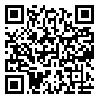BibTeX | RIS | EndNote | Medlars | ProCite | Reference Manager | RefWorks
Send citation to:
URL: http://sjh.umsha.ac.ir/article-1-1116-en.html
The aim of this project was to find out if influenza virus were involved in causing upper respiratory disease among susceptible people. One hundred and forty threat washings were collected from the patients living in Karaj, Tehran, and Mashhad during autumn and winter seasons in 1993. Sixty samples (43%) belonged to men and the rest were from women. All samples were inoculated into the amniotic and allantonic sacs of 9 to 11 day old day chick embryos, as well as hela cell cultures. Amniotic and allantoic fluids from the eggs were tested for haemagglutination of chick red blood cells.
Two samples were suspected of having influenza virus which were approved of being positive after haemagglutination inhibition test was done using specific sera. Using specific antisera received from the world health organization (WHO), the virus were identified as B/PANAMA/45/90. The above result was approved by WHO and was published in Weekly Epidemiological Record.
The viruses Isolated during this study belonged to samples collected from Karaj. Because influenza could cause complications in high-risk people, it is recommended to control the disease by immunizing them.
| Rights and permissions | |
 |
This work is licensed under a Creative Commons Attribution-NonCommercial 4.0 International License. |





